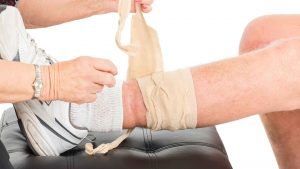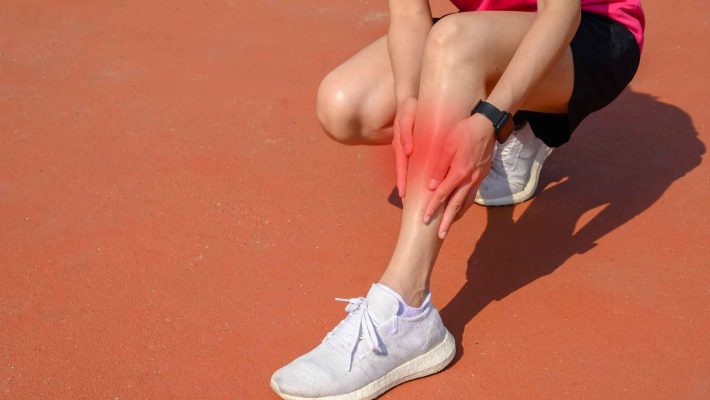Notice a dull pain across your shins every time you workout? That’s a shin splint. They occur far more often that you’d think. And, can cause great disturbance if left untreated. So, here’s how you can get the correct shin splints treatment.
First, what is a shin splint?
A shin splint is the pain down the front of your legs or the shins, caused by strenuous activities such as a cardio routine. Medically, Medial Tibial Stress Syndrome is the correct term for shin splints.
Beginners just starting with an intense cardio workout, seasoned athletes who are increasing the difficulty level of their workout routine, or just about anyone who does not maintain a correct posture while working out can experience Medial Tibial Stress Syndrome or shin splints. While it is easily treatable if diagnosed on time and cared for, ignoring the pain and working out regardless can lead to more serious and chronic pain.
What causes shin splints?
Anyone who has recently intensified their physical activity can experience shin splints. The sudden additional strain on the bone tissues, muscles, and tendons causes them to overwork. As a result, you can experience dull pains along the sides of the shin bone in your legs.
These are some of the reasons that lead to shin splints:
-
Not warming up before getting into a strenuous cardio routine
-
Running long distances on a hard concrete surface
-
Running on a rocky or uneven surface
-
Suddenly increasing the intensity of your workout routine without giving your body a chance to slowly build up strength for it
-
Not wearing comfortable shoes
-
Not giving your muscles enough rest and recovery time between consecutive workouts
What are the symptoms?
Shin splints are usually self-diagnosable. Some of the symptoms that suggest you are suffering from shin splints are:
-
Dull, throbbing pain below the knee
-
Pain or tenderness that worsens with any form of exercise
-
Mild swelling in the lower leg
-
Pain while walking or running or even prolonged standing
-
Feeling weakness in the bones and muscles of the lower leg
If you feel any of the above symptoms, stop the strenuous workout routine at once. Experts do not recommend continuing the activity that led to the pain in the first place. The good thing about a shin splint is that just like it is self-diagnosable, it is also self-treatable and preventable in the future.
What is the correct shin splints treatment?
If you do end up with shin splints, it is not a good idea to power through the pain and continue the strenuous routine.
For the correct shin splints treatment, the first and foremost is rest. It is important to take a break and give your body adequate rest to recover from the pain. A little downtime can do wonders for your recovery and the pain will subside.
By their very nature, shin splints subside almost as soon as you give yourself a break from physically strenuous exercises. But as you start to feel better, you may resume the workout too soon and the pain will return.
It is a vicious cycle that you will need to break. Light yoga and stretching heal the muscles and bone tissues in the lower leg and help in putting the shin splint behind you for good. But if a home-based shin splints treatment does not work, you may want to consult a specialist to figure out what is going on in there.
How can you prevent them?
If you are planning on changing your workout routine to something more intense, be sure to add it to your routine gradually. It will give your body the time to adjust to the added intensity. This can significantly reduce the chances of suffering from shin splints. You should also space out high-intensity workouts on alternate days of the week. If you are engaging in a high-intensity workout one day, take it to slow the next day. Engage in light stretching exercises or strength training that does not put too much strain on your legs.
Remember to choose proper shoes for the intended workout. If you plan on running, look for shoes that have soft and flexible soles. They are more comfortable and fit better. Better fitting shoes absorb the shock from jumping or hitting hard surfaces while running. That’s how they minimize the impact on your legs and prevent the chance of shin splints.
Can you still do cardio workouts?
With proper care and sufficient warming up, yes, of course, you can still do cardio.

Low impact cross-training such as the elliptical does not stress the shins and gives equally great results. Other cardio workouts that are not strenuous for the shins are swimming, cycling, and walking.
You can also get back to running if you want to, with a few precautionary measures in place. Wearing compression socks and shock absorbing orthotics to reduce the impact of hard surfaces can reduce the risk of recurrence of the pain. You can also incorporate exercises that target the shins in your warm-up and cool-down routine. Also, Stretch. Make stretching your best friend can help your muscles to relax after a strenuous workout.
With proper care, you can perform all your cardio exercises without sustaining shin injuries. You just need to be open to trying out alternatives. The main purpose of the exercise is to improve the health of your muscles. This becomes redundant if you exercise them under unnecessary strain. Never ignore the warning signs and always listen to your body.






